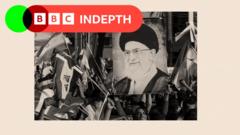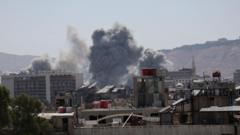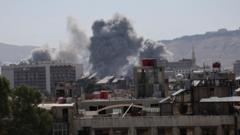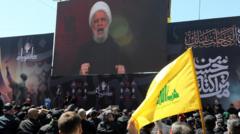Following direct military strikes on Iran's nuclear facilities by the US, the unfolding consequences hold the potential for historical ramifications. The geopolitical landscape is fraught with peril as Iran's leadership contemplates responses that could shift regional dynamics dramatically.
US-Iran Tensions Escalate: A Crossroad of Military Action and Diplomacy

US-Iran Tensions Escalate: A Crossroad of Military Action and Diplomacy
The stakes rise between the US and Iran as unprecedented military strikes alter the geopolitical landscape, demanding urgent responses from both nations.
The delicate balance between the United States and Iran has been disrupted in a momentous shift, as the US has escalated its military engagement in the region by targeting the Islamic Republic's critical nuclear infrastructure. This unprecedented action comes after decades of restraint where American leaders feared just such a reckless move could trigger a catastrophic Middle Eastern conflict.
In a striking departure from the past, the current president, who has pledged to pursue peaceful solutions, has taken bold steps deemed a provocation in global diplomatic circles. Reports suggest that Iran's supreme leader, aged 86, is now retreating into the safety of a bunker, reflecting the anxious state of the Islamic Republic post-strike.
Sanam Vakil, a noted expert from Chatham House, emphasizes the precarious position Khamenei finds himself in, contending that whether he retaliates with force or remains restrained, the implications could be dire for his legacy and governance. This suggests that Iran is confronted with a dual challenge - to maintain its image of strength while avoiding a miscalculation that could intensify American military involvement.
The recent Israeli airstrikes have compounded Iran's vulnerabilities, taking out key military leaders and compromising the operational capacity of the country’s security apparatus. Amid the heightened military tensions, the Islamic Revolutionary Guard Corps issued stark warnings to the US, claiming any misstep would lead to "lasting regret."
Nonetheless, analysts suggest Iran is reluctant to escalate further into full-fledged war. Observers, such as Hamidreza Aziz, stress that while the country’s reputation as a formidable regional player is shaken, overt aggression might bring catastrophic retaliation. The strategic Strait of Hormuz, which serves as a significant channel for global oil traffic, remains a touchpoint of concern; Iranian threats to close this waterway could destabilize the economic balance and draw multiple powers into conflict.
The pressure surrounding Iran is immense. The country's regional influence is visibly diminished due to ongoing Israeli assaults. As tensions flare, the primary question remains: What constitutes an acceptable retaliatory action for Iran without inviting a robust US response?
This crisis echoes a previous confrontation from five years ago when the assassination of IRGC commander Qasem Soleimani instigated fears of spiraling violence. That situation was deftly navigated by Iran through precise counterattacks that avoided significant US casualties.
Today's scenario appears far more intense. While President Trump attempts to redefine the US stance towards Iran as balancing diplomatic outreach with military pressure, Tehran perceives this as an ultimate betrayal of diplomacy. Iranians express dissatisfaction over demands to halt nuclear enrichment, viewing such conditions as undermining their sovereignty and strategic interests.
While Western leaders seek non-military intervention and dialogue, their shared anxiety about a nuclear-capable Iran looms large. The urgency of the moment cannot be overstated; any misjudgment risks not just regional destabilization but potential global economic backlash.
As newfound military dynamics continue to evolve, the pressure mounts on both US and Iranian leaders to navigate an increasingly treacherous geopolitical landscape, where every decision could lead to shifting alliances and unpredictable outcomes, making this a pivotal moment in the longstanding US-Iran confrontation.





















